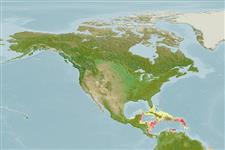>
Perciformes/Scorpaenoidei (Scorpionfishes) >
Scorpaenidae (Scorpionfishes or rockfishes) > Scorpaeninae
Etymology: Scorpaenodes: Latin, scorpaena = a kind of fish, 1706 + Greek oides = similar to (Ref. 45335); barrybrowni: Named for Barry Brown, substation Curaçao and free-lance photographer (www.coralreefphotos.com)..
Environment: milieu / climate zone / depth range / distribution range
Ecologia
marino associati a barriera corallina; distribuzione batimetrica 95 - 160 m (Ref. 109716). Deep-water
Distribuzione
Stati | Aree FAO | Ecosystems | Presenze | Point map | Introduzioni | Faunafri
Caribbean: Curaçao, Bonaire and Dominica.
Size / Peso / Age
Maturity: Lm ? range ? - ? cm
Max length : 4.7 cm SL maschio/sesso non determinato; (Ref. 109716)
Short description
Morfologia | Morfometria
Spine dorsali (totale): 13; Raggi dorsali molli (totale): 8; Spine anali 3; Raggi anali molli: 5; Vertebre: 24. This species is distinguished by the following set of characters: D soft rays 8; pectoral-fin rays 16-17, rays 11-12 (from uppermost ray) are noticeably longer than rest in smallest four type specimens; caudal-fin rays 25-27; vertebrae 8 precaudal + 16 caudal = 24; spines on suborbital ridge 4 (rarely 5); no secondary suborbital ridge spines; 2 prominent round to oblong pores in suborbital sensory canal immediately ventral to suborbital ridge; absence of coronal, interorbital, upper post temporal and postorbital spines; incomplete lateral line, 8-10 pored scales extending from behind supracleithral spine to mid body; cirri associated with
nasal, supraocular, and parietal spines and present on posteroventral projection of lacrimal
and upper left quadrant of the orbit; no cirri associated with postocular, tympanic,
supracleithral, and lower posttemporal spines; relatively elongate body, its depth at origin
of dorsal fin 30-32% SL, depth at caudal peduncle 9-10% SL; when alive, colour bright
orange-red with several reddish-brown bars on posterior portion of trunk, the pectoral fin
with vivid yellow spots interspersed with bright orange-red spots (Ref. 109716).
Collected on rocky substrata on a vertical rock wall (Ref. 109716).
Life cycle and mating behavior
Maturità | Riproduzione | Deposizione | Uova | Fecundity | Larve
Baldwin, C.C., D.E. Pitassy and D.R. Robertson, 2016. A new deep-reef scorpionfish (Teleostei: Scorpaenidae, Scorpaenodes) from the southern Caribbean with comments on depth distributios and relationships of western Atlantic members of the genus. ZooKeys 606:141-158. (Ref. 109716)
IUCN Red List Status (Ref. 130435)
Threat to humans
Harmless
Human uses
Informazioni ulteriori
StatiAree FAOEcosystemsPresenzeIntroduzioniStocksEcologiaDietaPredeConsumo di ciboRazione
Nomi ComuniSinonimiMetabolismoPredatoriEcotossicologiaRiproduzioneMaturitàDeposizioneSpawning aggregationFecundityUovaEgg development
Age/SizeAccrescimentoLength-weightLength-lengthLength-frequenciesMorfometriaMorfologiaLarveDinamica popolazioni larvaliReclutamentoAbbondanzaBRUVS
BibliografiaAcquacolturaProfilo di acquacolturaVarietàGeneticaElectrophoresesEreditarietàMalattieElaborazioneNutrientsMass conversion
CollaboratoriImmaginiStamps, Coins Misc.SuoniCiguateraVelocitàModalità di nuotoArea branchialeOtolithsCervelliVista
Strumenti
Special reports
Download XML
Fonti Internet
Estimates based on models
Phylogenetic diversity index (Ref.
82804): PD
50 = 0.5000 [Uniqueness, from 0.5 = low to 2.0 = high].
Bayesian length-weight: a=0.01259 (0.00606 - 0.02615), b=3.03 (2.86 - 3.20), in cm total length, based on LWR estimates for this (Sub)family-body shape (Ref.
93245).
Trophic level (Ref.
69278): 3.3 ±0.5 se; based on size and trophs of closest relatives
Resilienza (Ref.
120179): Alto, tempo minimo di raddoppiamento della popolazione meno di 15 mesi (Preliminary K or Fecundity.).
Fishing Vulnerability (Ref.
59153): Low vulnerability (10 of 100).
